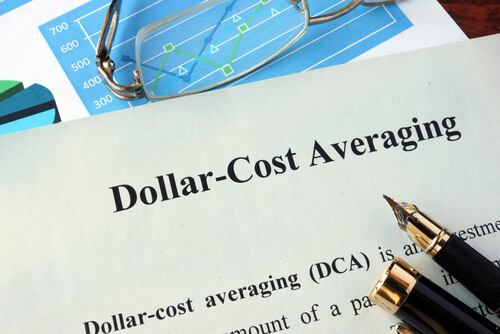Investing is known to be a challenging process. Even the most experienced investors sometimes need help to time the market to buy at the best moments correctly. Dollar-cost averaging is an investing approach that can make dealing with uncertain markets easier by automatic purchases. Also, it supports investors’ efforts to invest regularly.
Process of dollar-cost averaging
This can also be called a constant dollar plan. Dollar-cost averaging is investing the same amount of money in an aimed security at regular intervals over a particular time. By applying dollar-cost averaging to their strategy, investors could lower their average cost per share and lessen the impact of volatility in their portfolios. If effective, it would eliminate the efforts needed to time the market to purchase at the best prices.
Price movements don’t only go one way. Dividing your purchase and making several buys can increase your windows of paying a lower average price over time. Also, dollar-cost averaging contributes to getting your money to work consistently, which is an essential ingredient for long-term investment growth.
In addition, dollar-cost averaging removes the emotional factor in investing by making you purchase the same small amount of assets regularly. As a result, you buy fewer shares when prices become expensive and more when prices are affordable.
According to experts, this approach is one of the best strategies for starting investors who want to enter Exchange Traded Funds (ETFs). Also, several dividend reinvestment plans enable investors to dollar-cost average through regular purchases.
Role of time in dollar-cost averaging
Many investors claim that there are specific days to bring out money due to payroll schedules and mutual fund flows. However, if that were true, everyone would buy without figuring out other strategies.
The time or date you pick when to dollar-cost average is crucial since you must create and commit to a consistent plan. Through dollar-cost averaging, you may abstain from gains you might earn if you invested in a lump-sum purchase with a rising stock.
Also, the success of a large purchase heavily relies on the correct market timing. Besides, investors are known for being bad at predicting short-term movement in a stock or market.
When a stock moves lower in the near term, dollar-cost averaging would tell you to come out before a lump-sum purchase if the stock moves up again.
What are its benefits?
The downward movement of stocks tends to push people to be fearful, leading them to sell. Therefore, when the market goes back up, they could miss out on possible gains. However, once the stock market goes up, investors might be tempted to rush but may end up purchasing the stock that is about to drop.
The practice of dollar-cost averaging encourages you to keep investing the same amount without considering the fluctuations of the market. In addition, it can help you hold yourself back from being tempted to time the market. Instead of giving out all your money at once, this approach could limit your losses if the market declines.
It prevents investors from psychological biases because they are likely to shift between fear and greed and are prone to making trading decisions emotionally when the market moves. Other times, it can help you realize that a crashing stock market can be an excellent long-term investing opportunity rather than being seen as a threat.
How about its downsides?
Although dollar-cost averaging is a helpful process to lower risks, investors who apply this strategy could give up potentially higher returns. It often produces lower returns than lump sum investing, especially over more extended periods.
On the other hand, the possibility of missing out on potential gains you could have earned does not apply to your 401(k) since you are investing the money while you earn it rather than holding it as cash until a later date.
It is also essential to note that engaging in this method might cause you to encounter more brokerage fees, damaging your returns. Plus, it would be best if you were disciplined with money on the sidelines to invest without hurting it with purchases.
Know if you need it
When it comes to investing, you may experience a lot of anxiety. Dollar-cost averaging can reduce this negativity and give you a controlled way to grow your funds continuously. Here are some things to follow if you are interested in this approach.
Calculate how much you want to invest
It could be a one-time benefit that you aim to put on the market, or you can choose a specific amount you want to contribute within a regular schedule for an unspecified period.
Know how often you want to invest
You can choose if you wish to do this daily, weekly, or monthly. Also, you can try customizing your time interval if you find it the most convenient.
Determine the number of periods you aim to split the investment over
Depending on what works for you, you can only do it a few times, or it can serve as the beginning of a permanent routine.
Compute the amount you want to invest per interval
For a lump sum, divide the amount by the number of periods. For indefinite investment plans, calculate the budget that you can reliably afford.
Stick to the plan regardless of the market’s movement
Suppose your investment target is to increase your net worth, but you are anxious about temptations. You can turn to dollar-cost averaging to effectively build your portfolio without dealing with these worries.
How to start?
Dollar-cost averaging could be as simple as investing in an Individual Retirement Account (IRA) with some legwork. Although setting up a plan with most brokerages is easy, picking the right stock or ETF to purchase is essential.
Instruct your brokerage to plan to purchase in regular intervals automatically. If your brokerage account fails to offer an automatic trading plan, consider setting up your purchases with a fixed schedule.
You can suspend some investments to maintain regular investing without considering stock prices and market concerns. Keep in mind that declining markets could be an opportunity for dollar-cost averaging.
To increase effectivity, you can instruct a brokerage to reinvest the dividends from many stocks and funds that pay dividends. This way, you could keep buying the stock and compound your gains over time.











